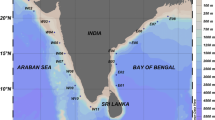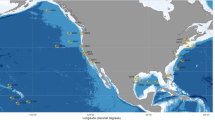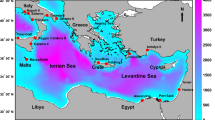Abstract
Spectral numerical wave models are unable to predict extreme sea conditions accurately, and the probability of occurrence of a given wave parameter for fixed return periods (RPs) remains unexplored by such an approach. In this study, the significant wave height (SWH) parameter that plays a major role in ocean engineering and marine and naval activities was estimated spatially for the entire Bay of Bengal (BOB) region for the given RPs. Spatially gridded 44 years of SWH data at a spatial resolution of 1° × 1° were considered, and return value maps were generated for the BOB for 10-, 15-, 25-, 50-, and 100-year RPs. The peak over threshold (POT) model was chosen over a generalized Pareto distribution for data fitting and calculating the return values. As there is no existing method to determine the threshold value for use in the POT model, in this study, for the first time, an algorithm was designed to calculate the threshold value, which determined the accuracy of the estimation. Along with the conventional time-series analysis of the SWH data using POT, the novelty of the study lies in the spatial return period maps generated for the entire BOB region leading to the basin scale estimation.









Similar content being viewed by others
References
Goda, Y. (2000). Statistical analysis of extreme waves. In P. L.-F. Liu (Ed.), Random seas and design of maritime structures. 15th volume of advanced series on ocean engineering (Chap. 11, pp. 377–425). Singapore: World Scientific Publishing Co.
Draper, L. (1973). Extreme wave conditions in British and adjacent water. In 13th coastal engineering conference (pp. 157–165). ASCE.
Ploeg, J. (1968). A general discussion on the selection of a design wave. In 2nd marine engineering seminar, Canada.
Caires, S. (2011). Extreme value analysis: Wave data. JCOMM technical report no. 57. http://www.jodc.go.jp/info/ioc_doc/JCOMM_Tech/JCOMM-TR-057.pdf.
Coles, S. (2001). An introduction to statistical modeling of extreme values (p. 208). London: Springer.
Thompson, P., Yuzhi, C., Dominic, R., & Julian, S. (2009). Automated threshold selection methods for extreme wave analysis. Coastal Engineering,56, 1013–1021.
Lecacheux, S., Pedreros, R., Le Cozannet, G., Thiébot, J., De La Torre, Y., & Bulteau, T. (2012). A method to characterize the different extreme waves for islands exposed to various wave regimes: A case study devoted to Reunion Island. Natural Hazards and Earth Systems Sciences,12, 2425–2437.
Davison, A. C., & Smith, R. L. (1990). Models for exceedances over high thresholds. Journal of the Royal Statistical Society: Series B,52, 393–442.
Katz, R. W., Parlange, M. B., & Naveau, P. (2002). Statistics of extremes in hydrology. Advances in Water Resources,25, 1287–1304.
Méndez, F. J., Menéndez, M., Luceño, A., & Losada, I. J. (2006). Estimation of the long-term variability of extreme significant wave height using a time-dependent peak over threshold (POT) model. Journal Geophysical Research,111, C07024. https://doi.org/10.1029/2005JC003344.
Smith, R. L. (2001). Environmental statistics. Technical report, Department of Statistics, University of N.C., Chapel Hill.
Brink, H. W., & Können, G. P. (2011). Estimating 10000-year return values from short time series. International Journal of Climatology,31, 115–126.
Martucci, G., Carniel, S., Chiggiato, J., Sclavo, M., Lionello, P., & Galati, M. B. (2010). Statistical trend analysis and extreme distribution of significant wave height from 1958 to 1999—An application to the Italian Seas. Ocean Science,6, 525–538.
Sartini, L., Mentaschi, L., & Besio, G. (2015). Comparing different extreme wave analysis models for wave climate assessment along the Italian coast. Coastal Engineering,100, 37–47.
Samayam, S., Valentina, L., Annamalaisamy, S. S., Arena, F., Vallam, S., & Gavrilovich, P. V. (2017). Assessment of reliability of extreme wave height prediction models. Natural Hazards and Earth System Sciences,17, 409–421.
Acknowledgements
This study is a part of a project (SR/FTP/ES80/2013) under Science and Engineering Research Board (SERB) under Department of Science and Technology (DST), Government of India, and the authors of the study would like to thank DST for sponsoring the project. The authors also thank European Centre for Medium-Range Weather Forecasts (ECMWF) for the datasets.
Author information
Authors and Affiliations
Corresponding author
Ethics declarations
Conflict of interest
On behalf of all the authors, the corresponding author states that there is no conflict of interest to report with respect to this paper.
Additional information
Publisher's Note
Springer Nature remains neutral with regard to jurisdictional claims in published maps and institutional affiliations.
Electronic supplementary material
Below is the link to the electronic supplementary material.
Rights and permissions
About this article
Cite this article
Roy, S., Sinha, M. & Pradhan, T. Generation of 100-year-return value maps of maximum significant wave heights with automated threshold value estimation. Spat. Inf. Res. 28, 335–344 (2020). https://doi.org/10.1007/s41324-019-00293-x
Received:
Revised:
Accepted:
Published:
Issue Date:
DOI: https://doi.org/10.1007/s41324-019-00293-x




